|
Flow Research is now working on The World Market for Primary Elements,
3rd Edition, our first complete overview of primary elements in
five years. We are happy to report that the market is riding a wave of growth in the oil & gas industry and doing well.
This
upcoming study details the current size of the worldwide primary elements market, the leading suppliers’ market shares, and market forecasts for the next
five years.
The study
presents:
• 2024 market size in US dollars and unit volume for primary elements worldwide
• 2024 market shares of the leading primary element suppliers worldwide
• Forecast of the growth market for primary elements in dollars and unit volumes through
2029
• Segmented data both worldwide and for each of eight global regions
• Product analysis for the significant primary element suppliers
• Industries and applications where primary elements are used, plus market growth sectors
• Market and product strategies for primary element suppliers
• Company profiles for significant primary element suppliers worldwide
Why the
primary element market is growing
The rise of crude oil prices since
2022 has revved up oil & gas exploration and production activity worldwide. That surge has increased sales of differential pressure (DP) flowmeters, which are among the most widely used flowmeters in the industry. This is good news for primary elements, which suppliers combine with DP transmitters to create DP flowmeters.
Other factors are also fueling the growth of the primary elements market:
Environmental standards and regulations for monitoring flare gas
and stack gas emissions. In response to continuous emission monitoring (CEM) requirements, primary elements companies developed averaging Pitot tubes that use measurements at multiple locations to compute flow for the entire pipe, duct, or stack.
Increasing popularity of multivariable and integrated DP flowmeters. The multivariable DP transmitter market is growing as new suppliers of these more sophisticated devices enter the market. In addition, integrated DP flowmeters in which the transmitter and primary element are paired at the factory and sold as a single unit are also gaining in popularity.
Technological
improvements. Product enhancements designed to solve specific application needs include extreme high-pressure wedge elements, cone-based meters, single and dual chamber housings, and hybrid combinations (i.e. flow nozzle with elements of an averaging Pitot tube).
Strong installed base. DP flowmeters have a very large installed base that almost guarantees the primary element – and differential pressure flow transmitter -- market will continue to hold its own within the instrumentation world.
How primary elements work
Primary elements place a constriction in the flow line that creates a pressure drop in the line. The DP transmitter uses the difference between upstream pressure and downstream pressure in the line as a basis for computing flow.
DP flow measurement – and the use of primary elements -- officially dates to at least the 17th century -- though the measurement of flow using nozzles actually goes way back to Roman times. In the early 1600s, Italian scientists Benedetto Torricelli and Evangelista Castelli arrived at the concepts that underlie differential pressure measurement today: that flowrate equals velocity times pipe area, and that the flow through an orifice varies with the square root of the head.
In 1738, Daniel Bernoulli developed his famous equation for flowrate calculation that shows increasing velocity by constricting a flow path increases fluid pressure.
The first commercial orifice plate flowmeter appeared in 1909, and was used to measure steam flow. Shortly
thereafter, the oil and gas industries began using orifice plate flowmeters due to ease of standardization and low maintenance. Since that time a range of other primary elements have gained popularity.
Our most recent study looks at seven types of primary elements:
• Orifice measuring points
• Averaging Pitot tubes
• Venturi tubes
• Flow nozzles
• Wedge elements
• Cone elements
• Other primary elements –
low loss flow tubes, Dall tubes, and laminar flow elements
Orifice plates are the most common type of primary element. An orifice plate is a flat, usually round piece of metal, often steel, with an opening or “orifice” in it. The orifice plate needs to be positioned at a correct position in the flowstream for it to function as a primary element in a DP flow measurement.
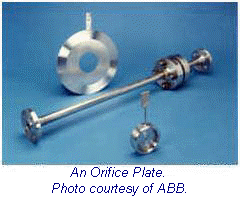
Since an orifice plate cannot serve as a functioning primary element unless it is held in proper position, and since valve manifolds are required for most DP flowmeter measurements, an orifice measuring point is defined here as having the following three components:
1. Orifice plate
2. Orifice assembly, flange, or holding element
3. 3-valve or 5-valve manifold that isolates the pressure transmitter from the process valve manifold
Orifice plates are classified according to the shape and position of the hole or opening they contain. The following are the main types of orifice plates:
• Concentric
• Conical
• Eccentric
• Integral
• Quadrant
• Segmental
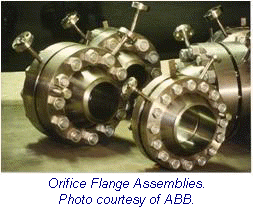
The Pitot tube is named for Henri Pitot, who invented it in 1732. Henry Philibert Gaspard Darcy, another Frenchman, published a paper in 1858 that made improvements on Pitot’s invention. The first patent for the use of a Pitot tube to measure velocity in pipes was given to Henry Fladd of St. Louis, Missouri, in 1889.
Pitot tubes are of two types:
• Single port
• Multiport averaging Pitot tubes
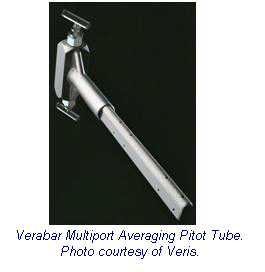
A single port Pitot tube includes an L-shaped tube measuring impact pressure. This tube is inserted into the flowstream, with the opening facing directly into the flow. Another tube measuring static pressure has an opening parallel to the direction of flow. Flowrate is proportional to the difference between impact pressure and static pressure.
A multiport averaging Pitot tube has multiple ports to measure impact pressure and static pressure at different points. The DP transmitter computes flowrate by taking the average of the differences in pressure readings at different points.
Emerson Rosemount, Veris and other companies have introduced proprietary versions of the averaging Pitot tube. Emerson Rosemount’s proprietary version is called the Annubar, and it was formerly sold by Dieterich Standard, now part of Emerson Process Management. Veris’ averaging Pitot tube is called the
Verabar.
The Venturi tube was invented by an Italian physicist named Giovanni Battista Venturi in 1797. In 1887, Clemens Herschel to develop the first commercial flowmeter based on Venturi’s work. His version of the Venturi flowmeter became known as the Herschel Standard Venturi. Herschel published his paper called “The Venturi Water Meter” in 1898. In 1970, a company called BIF introduced the Universal Venturi Tube™.
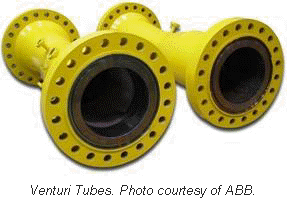
A Venturi tube is a flow tube that has a tapered inlet and a diverging
exit. The DP transmitter
measures the pressure drop and uses this value to calculate flowrate.
A flow nozzle is a flow tube with a smooth entry and a sharp exist. Flow nozzles are mainly used for high-velocity, erosive, non-viscous flows. Flow nozzles are sometimes used as an alternative to orifice plates when erosion or cavitation would damage an orifice plate. They offer excellent long-term accuracy.
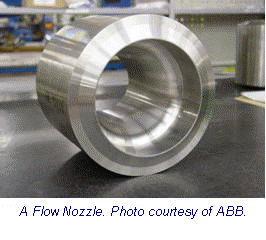
A wedge element is a flow tube that has a V-shaped flow restriction – the “wedge” – protruding into the flowstream from at least one side of the pipe. The wedge might be attached and contained inside the pipe or it might be created by heavy sections of metal welded into a notch cut in the pipe. In the latter case, there are often reinforcing bars across the notch (parallel to the length of the pipe). In any case, the wedge is solidly built in, making these elements extremely robust, with no moving parts, no critical areas to wear or shift.
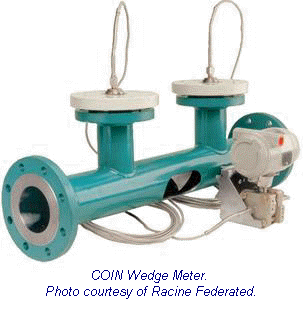
Wedge elements can handle any type of flow profile, whether laminar, transitional, or turbulent, and they are less prone to clogging or buildup than some other element types. The wedge shape is usually symmetrical – presenting the same on the upstream and downstream sides – thus allowing for bi-directional flow. Or, in the case of highly erosive fluids, should there eventually be significant-enough wear on one side of the wedge, the flow tube can be turned around to present the unworn side to the flow thus prolonging the life of the meter. They are easy to install and easy to use.
Wedge elements are designed to measure fluids with a high solids content. They are also well-suited for air, viscous flows, and slurries
Cone-type primary elements are the second fastest-growing primary element behind orifice plates. They are suitable for measuring gas, liquid, and steam and are considered good choices for difficult measurements such as corrosive fluids.
Cone elements are designed for flow measurement with minimal upstream piping – they have minimum upstream and downstream straight-run requirements, which saves space in both initial and replacement installations.
Cone-based DP flowmeters were introduced by McCrometer in 1987 as V-Cone® and are now also supplied by Cameron, EMCO Controls and other companies.
Other primary elements include low loss flow tubes, Dall tubes, and laminar flow elements.
Low loss flow tubes are designed to produce a minimum amount of permanent pressure loss. They can be made in many sizes and materials for a variety of applications handling water, wastewater, sludge, slurries, clean fluids, and gases in full pipe conditions, and are ideally suited to applications where minimum permanent pressure loss is important, such as in gravity-fed systems, or where saving on pumping costs is desirable.
The Dall
tube, invented by an ABB hydraulics engineer named Horace E. Dall, is an adaptation of the Venturi tube. Dall tubes offer the lowest permanent pressure loss of any DP measurement device. Drawbacks are that it is complex to manufacture, sensitive to turbulence, and not suitable for hot feed water or fluids with suspended solids. Two of the companies in this market today are Solartron ISA (in the UK, owned by AMETEK) and MATTECH, s.r.o. (in the Czech Republic).
Laminar flow elements
are lower in cost than most other primary elements and can be made in sizes and materials to handle a wide range of clean, non-condensing gas and air flows. Laminar flow elements are used with mass flow controllers to create a pressure drop and a flow measurement. Their accuracy, stability, response time, and repeatability make them excellent for critical gas flow measurement applications as well as for calibration of various process instruments including some flowmeters, flow regulators, and thermal anemometers.
Click to learn
more about other technologies in:

Info on DP Flow:
www.FlowElement.com
www.DPMeter.com
For
further information on differential pressure, including studies and articles,
see www.FlowDP.com.
|